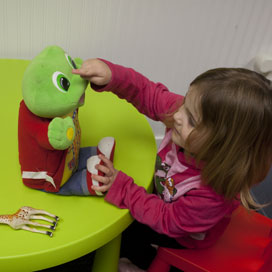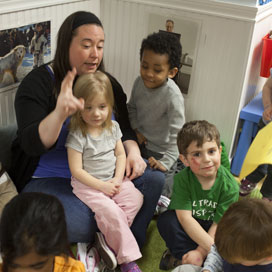
Set up a system for each child to pick a read-aloud selection. Encourage families to lend the class the children’s favorite books from home for the day. Set up a special chair for the child to sit in during reading time. Ask the child why the book is a favorite and offer thanks for sharing it with the class.
 Choosing a book for the class to enjoy will help the children learn to make choices. They will build their literacy, listening and sequencing skills. Listening to the story will build the children’s imagination as they explore ideas in new ways.
Choosing a book for the class to enjoy will help the children learn to make choices. They will build their literacy, listening and sequencing skills. Listening to the story will build the children’s imagination as they explore ideas in new ways.

Introduce the game “I Spy” to the children. Focus on one color at a time. Make the game simpler by saying, “What do you see that is green?” and accept all correct responses. Ask the children to help you make a list of all of the items that you found that represented the chosen color. Keep the list visible and let the children use it when they play school in Dramatic Play.
 Identifying colors in nature will help the children build their vocabulary, oral language development, and observation skills. Writing down the children’s ideas will help them understand that words are made of letters that we can share with other people.
Identifying colors in nature will help the children build their vocabulary, oral language development, and observation skills. Writing down the children’s ideas will help them understand that words are made of letters that we can share with other people.

Write a list of songs and fingerplays that you regularly use. Model how to read the lists by pointing to the words. Using a special pointer, such as a magic wand or finger pointer, makes it more fun for the children. Ask volunteers to help you read the lists and to choose a song or fingerplay from the lists.
 Seeing a list of songs and fingerplays will help the children make the letter/word connection. Allowing them to participate in choosing a song builds their self-esteem and teaches them to speak in front of groups. Seeing the lyrics and words help build their literacy skills.
Seeing a list of songs and fingerplays will help the children make the letter/word connection. Allowing them to participate in choosing a song builds their self-esteem and teaches them to speak in front of groups. Seeing the lyrics and words help build their literacy skills.
